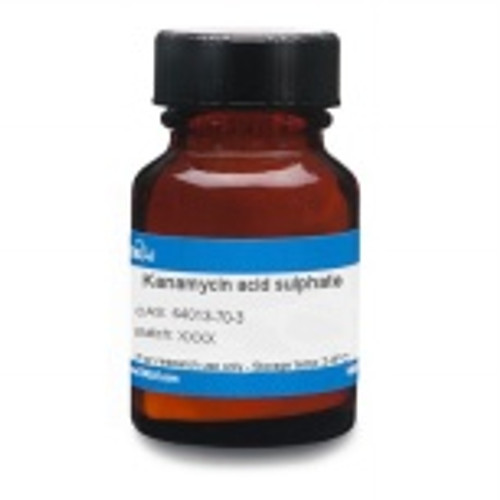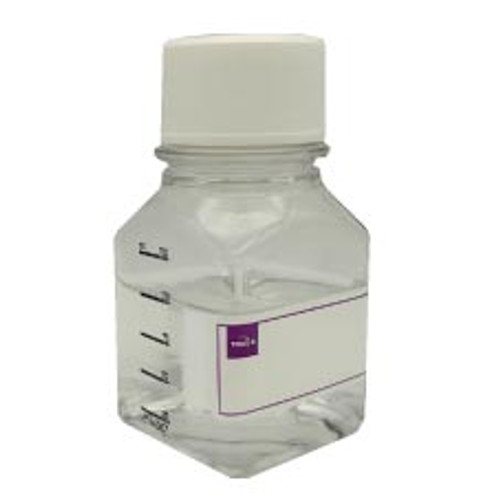Kanamycin Sulfate, USP is a semi-synthetic, broad-spectrum aminoglycoside antibiotic. Kanamycin was isolated from the soil bacterium Streptomyces kanamyceticus in 1957 by Hamao Umezawa at the institute of Microbial Chemistry (Tokyo) during an antitumor screening program using the transplanted Yoshida sarcoma in mice. Kanamycin inhibits protein synthesis in bacteria and Mycoplasma. It is used to select for transformants (bacteria, fungi, plant, mammalian) which have been successfully transformed with a plasmid containing a kanamycin-resistance gene.
Standard-grade Kanamycin is composed of 3 fractions: Kanamycin A, B, and C, with Kanamycin A being the major component.
Kanamycin Sulfate is soluble in water but is practically insoluble in ethanol, DMSO, acetone, chloroform, ether and ethyl acetate.
We also offer:
- Kanamycin Acid Sulfate, BP (K004)
- Kanamycin Acid Sulfate, EP (K029)
- Kanamycin A Sulfate, EvoPure® (K013)
- Kanamycin B sulfate, EvoPure® (K014)
| Mechanism of Action | Aminoglycosides target the 30S ribosomal subunit resulting in an inability to read mRNA ultimately producing a faulty or nonexistent protein.
Resistance to aminoglycosides are due the presence of aminoglycoside-modifying enzymes (acetyltransferase, phosphotransferase, nucleotidyltransferase). |
| Spectrum | Kanamycin Sulfate is a broad-spectrum antibiotic but is most active against aerobic Gram-negative bacteria. |
| Eukaryotic Cell Culture Applications | Kanamycin Sulfate was used in an in vitro model system of Henle intestinal epithelial cell infection (Henle 407 cell line) by Shigella flexneri. Bactericidal levels of Kanamycin ablated infectivity of Shigella (Hale and Bonventre, 1979). |
| Cancer Applications | Kanamycin was used in an experimental mouse model of colorectal cancer. Following short-term induction of colitis by an irritant (dextran sulfate sodium), colon cancer cells (colon 26) were instilled intrarectally. The result was that tumors formed at the luminal mucosal surface. This model is useful to examine chemotherapeutic agents that may suppress the growth of colorectal cancer (Takahashi et al, 2004). |
| Microbiology Applications | Kanamycin Sulfate is commonly used as a selective agent to select for resistant mammalian, fungal, or bacterial cells that contain the kanMX marker or other Kanamycin resistance genes. Kanamycin Sulfate is typically used at a concentration of 50 µg/mL.
Kanamycin Sulfate is commonly used for in vitro microbiological antimicrobial susceptibility tests (panels, discs, and MIC strips) against Gram-positive and Gram-negative microbial isolates. Medical microbiologists use AST results to recommend antibiotic treatment options. For additional MIC data for Kanamycin Sulfate, visit our Antimicrobial Index. Media SupplementsKanamycin can be used as a selective agent in several types of isolation media: Kanamycin Aesculin Azide Agar - Enterococci isolation in food Perfringens Agar - SFP and TSC selective supplements for the isolation of Clostridium perfringens |
| Plant Biology Applications | Kanamycin is often used in the Agrobacterium-mediated transformation using the neomycin phosphotransferase gene (npt II gene) as a selection marker which confers resistance to Kanamycin (and G418).
Gene transfer to cereal cells (Triticum monococcum) mediated by protoplast transformation with naked DNA. Plasmid contained a gene of interest along with the NTP II gene, and transformed were selected in medium containing Kanamycin (Lorz et al 1985). In a study of drought and salt tolerance, soybeans (DT84 cultivar) were genetically modified using Agrobacterium-mediated transformation to insert the GmDREB6 gene along with the nptII gene to select for plants resistant to Kanamycin. GmDREB6 is a dehydration-responsive element binding proteins (DREBs), a plant transcription factor that binds to specific region of promoter to activate expression of mechanisms to cope with cellular dehydration. Overexpression of GmDREB6 increased transcription levels of GmP5CS gene, which caused a higher intracellular proline content in plants growing under salt stress (Nguyen et al, 2019). |
| Molecular Formula | C18H36N4O11 · H2SO4 |
| References |
Pryjma, et al. used Kanamycin Sulfate (TOKU-E) to select for transformed Kanamycin resistant Campylobacter jejuni cells in: FdhTU-modulated formate dehydrogenase expression and electron donor availability enhance recovery of Campylobacter jejuni following host cell infection. Davis BD (1987) Mechanism of bactericidal action of Aminoglycosides. Microbiol. Rev. 51(3):341-350 Grant CCR, Konkel ME, Cieplak Jr W, and Tompkins LS (1993) Role of flagella in adherence, internalization, and translocation of Campylobacter jejuni in nonpolarized and polarized epithelial cell cultures. Infect. and Immun. 61(5):1764-1771 Lorz H, Baker B and Schell J (1985) Gene transfer to cereal cells mediated by protoplast transformation. Molec. And Gen. Genetics 199:178-182 Nguyen QH et al (2019) Overexpression of the GmDREB6 gene enhances proline accumulatin and salt tolerance in genetically modified soybean plants. Sci Rep. 9:19663 PMID 31873128 Sneader W (2005) Drug Discovery: A history. John Wiley & Sons pp 302 Takahashi T, Morotomi Ma nd Nomoto K (2004) A novel mouse model of rectal cancer established by orthotopic implantation of colon cancer cells. Cancer Sci. 95(6):514-519 PMID 15182433 |
| MIC | Bacillus subtilis| 3.9|| Candida albicans| 2000|| Escherichia coli| 31.2|| Salmonella Enteritidis| 62.5|| Staphylococcus aureus| 31.2|| |








